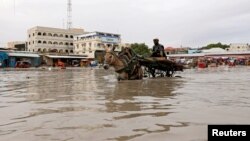The World Food Program is calling for stronger international support for hundreds of thousands of Somalis impacted by some of the heaviest rains to hit their country in three decades. The rainfall that began last month has caused widespread flooding and damage in central, south and north Somalia.
For much of the last decade, Somalia has struggled with chronic drought. The 2011 drought was especially bad, killing an estimated 260,000 people.
Now Somalia has the opposite problem -- too much rain.
About one month ago, President Mohamed Abdullah Mohamed appealed for international support to help hundreds of thousands of people displaced by heavy flooding.
The response has been somewhat tepid. The World Food Program says it is concerned the situation will become even more difficult since the disaster has slipped out of the world’s headlines.
The agency reports nearly 300,000 of the 700,000 people affected by the floods are homeless. WFP spokeswoman Bettina Luescher says her agency is doing what it can to support livelihood and safety net activities to build up resilience.
“But, we are once again under-funded. We need some $120 million to assist the people in Somalia until the end of October. As you know, last year, we were fighting to avoid a famine in Somalia. We have to keep on pushing to make sure that all the gains that we were able to make last year when we were able to fight off a famine can still be kept,” she said.
Earlier in the year, the U.N. appealed for $1.5 billion to provide aid to some five million people affected by drought and conflict. Less than $370 million, or 24 percent, has been received. U.N. officials say that isn’t enough to support a robust flood response.
Luescher says WFP is aiming to reach three million people in Somalia this year. She says work is going on in partnership with other agencies to reach the flood victims. She says the WFP is distributing high-energy biscuits and handing out two-month supplies of food rations in some areas.
She says many places are inaccessible by road, so aid workers are using boats to reach people cut off by the floods. She says the WFP, which operates the U.N. Humanitarian Air Service, also has added a helicopter to its fleet to transport aid workers to flood-affected areas.





